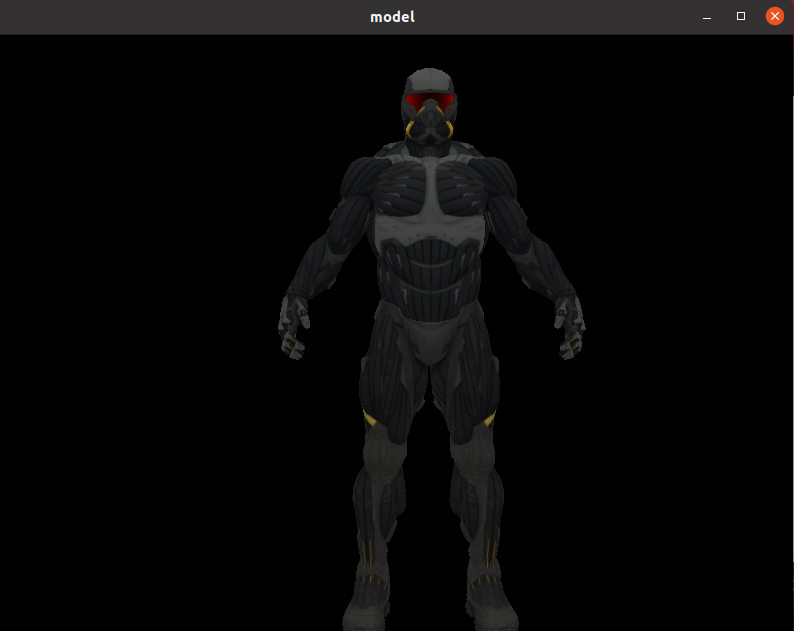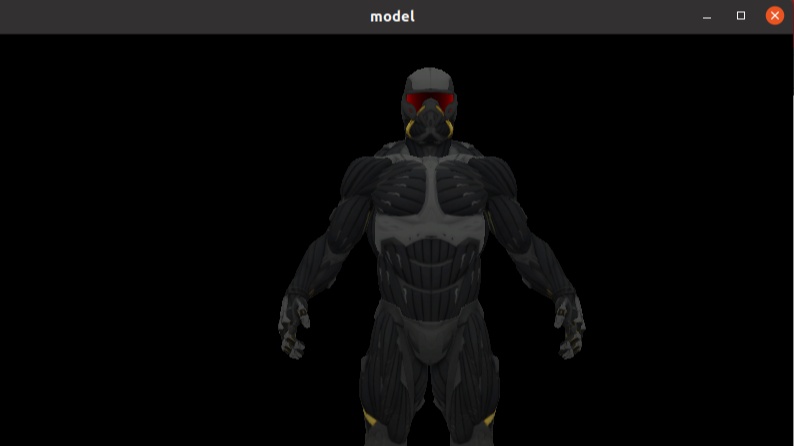基于C++的OpenGL 14 之模型加载
1. 引言
本文基于C++语言,描述OpenGL的模型加载
前置知识可参考:
笔者这里不过多描述每个名词、函数和细节,更详细的文档可以参考:
2. 概述
3D建模工具(3D Modeling Tool)会在导出到模型文件的时候自动生成所有的顶点坐标、顶点法线以及纹理坐标
所以,解析这些导出的模型文件以及提取所有有用的信息,将它们储存为OpenGL能够理解的格式,就可以进行绘制
Assimp是一个非常流行的模型导入库,能够导入很多种不同的模型文件格式(并也能够导出部分的格式),会将所有的模型数据加载至Assimp的通用数据结构中
Assimp的GitHub站点为:assimp/assimp: The official Open-Asset-Importer-Library Repository. Loads 40+ 3D-file-formats into one unified and clean data structure. (github.com)
3. 编写Model类
一个完整的模型往往是由多个组件构成,单个的组件称之为Mesh
多个Mesh组成Model,Mesh类的定义见:基于C++的OpenGL 13 之Mesh - 当时明月在曾照彩云归 - 博客园 (cnblogs.com)
这里定义Model类
class Model { public: /* 函数 */ Model(char *path) { loadModel(path); } void Draw(Shader shader); private: /* 模型数据 */ vector<Mesh> meshes; string directory; /* 函数 */ void loadModel(string path); void processNode(aiNode *node, const aiScene *scene); Mesh processMesh(aiMesh *mesh, const aiScene *scene); vector<Texture> loadMaterialTextures(aiMaterial *mat, aiTextureType type, string typeName); };
导入头文件:
#include <assimp/Importer.hpp> #include <assimp/scene.h> #include <assimp/postprocess.h>
加载模型函数:
void loadModel(string path) { Assimp::Importer import; const aiScene *scene = import.ReadFile(path, aiProcess_Triangulate | aiProcess_FlipUVs); if(!scene || scene->mFlags & AI_SCENE_FLAGS_INCOMPLETE || !scene->mRootNode) { cout << "ERROR::ASSIMP::" << import.GetErrorString() << endl; return; } directory = path.substr(0, path.find_last_of('/')); processNode(scene->mRootNode, scene); }
遍历Mesh:
void processNode(aiNode *node, const aiScene *scene) { // 处理节点所有的网格(如果有的话) for(unsigned int i = 0; i < node->mNumMeshes; i++) { aiMesh *mesh = scene->mMeshes[node->mMeshes[i]]; meshes.push_back(processMesh(mesh, scene)); } // 接下来对它的子节点重复这一过程 for(unsigned int i = 0; i < node->mNumChildren; i++) { processNode(node->mChildren[i], scene); } }
转换Mesh:
Mesh processMesh(aiMesh *mesh, const aiScene *scene) { vector<Vertex> vertices; vector<unsigned int> indices; vector<Texture> textures; for(unsigned int i = 0; i < mesh->mNumVertices; i++) { Vertex vertex; // 处理顶点位置、法线和纹理坐标 glm::vec3 vector; vector.x = mesh->mVertices[i].x; vector.y = mesh->mVertices[i].y; vector.z = mesh->mVertices[i].z; vertex.Position = vector; vector.x = mesh->mNormals[i].x; vector.y = mesh->mNormals[i].y; vector.z = mesh->mNormals[i].z; vertex.Normal = vector; if(mesh->mTextureCoords[0]) // 网格是否有纹理坐标? { glm::vec2 vec; vec.x = mesh->mTextureCoords[0][i].x; vec.y = mesh->mTextureCoords[0][i].y; vertex.TexCoords = vec; } else vertex.TexCoords = glm::vec2(0.0f, 0.0f); vertices.push_back(vertex); } // 处理索引 for(unsigned int i = 0; i < mesh->mNumFaces; i++) { aiFace face = mesh->mFaces[i]; for(unsigned int j = 0; j < face.mNumIndices; j++) indices.push_back(face.mIndices[j]); } // 处理材质 if(mesh->mMaterialIndex >= 0) { aiMaterial *material = scene->mMaterials[mesh->mMaterialIndex]; vector<Texture> diffuseMaps = loadMaterialTextures(material, aiTextureType_DIFFUSE, "texture_diffuse"); textures.insert(textures.end(), diffuseMaps.begin(), diffuseMaps.end()); vector<Texture> specularMaps = loadMaterialTextures(material, aiTextureType_SPECULAR, "texture_specular"); textures.insert(textures.end(), specularMaps.begin(), specularMaps.end()); } return Mesh(vertices, indices, textures); }
加载纹理函数:
vector<Texture> loadMaterialTextures(aiMaterial *mat, aiTextureType type, string typeName) { vector<Texture> textures; for(unsigned int i = 0; i < mat->GetTextureCount(type); i++) { aiString str; mat->GetTexture(type, i, &str); Texture texture; texture.id = TextureFromFile(str.C_Str(), directory); texture.type = typeName; textures.push_back(texture); } return textures; } unsigned int TextureFromFile(const char *path, const string &directory, bool gamma = false) { string filename = string(path); filename = directory + '/' + filename; unsigned int textureID; glGenTextures(1, &textureID); int width, height, nrComponents; unsigned char *data = stbi_load(filename.c_str(), &width, &height, &nrComponents, 0); if (data) { GLenum format; if (nrComponents == 1) format = GL_RED; else if (nrComponents == 3) format = GL_RGB; else if (nrComponents == 4) format = GL_RGBA; glBindTexture(GL_TEXTURE_2D, textureID); glTexImage2D(GL_TEXTURE_2D, 0, format, width, height, 0, format, GL_UNSIGNED_BYTE, data); glGenerateMipmap(GL_TEXTURE_2D); glTexParameteri(GL_TEXTURE_2D, GL_TEXTURE_WRAP_S, GL_REPEAT); glTexParameteri(GL_TEXTURE_2D, GL_TEXTURE_WRAP_T, GL_REPEAT); glTexParameteri(GL_TEXTURE_2D, GL_TEXTURE_MIN_FILTER, GL_LINEAR_MIPMAP_LINEAR); glTexParameteri(GL_TEXTURE_2D, GL_TEXTURE_MAG_FILTER, GL_LINEAR); stbi_image_free(data); } else { std::cout << "Texture failed to load at path: " << path << std::endl; stbi_image_free(data); } return textureID; }
绘制函数:
void Draw(Shader &shader) { for(unsigned int i = 0; i < meshes.size(); i++) meshes[i].Draw(shader); }
4. 调用Model类
编写test.cpp调用Model类,加载模型,结果如下:

模型下载地址为:https://learnopengl-cn.github.io/data/nanosuit.rar
5. 完整代码
Model类model.hpp:
#ifndef MODEL_HPP #define MODEL_HPP #include <assimp/Importer.hpp> #include <assimp/scene.h> #include <assimp/postprocess.h> #include "shader.hpp" #include "mesh.hpp" #include <string> #include <vector> class Model { public: /* 函数 */ Model(const char *path) { loadModel(path); } void Draw(Shader &shader) { for(unsigned int i = 0; i < meshes.size(); i++) meshes[i].Draw(shader); } private: /* 模型数据 */ vector<Mesh> meshes; string directory; /* 函数 */ void loadModel(string path) { Assimp::Importer import; const aiScene *scene = import.ReadFile(path, aiProcess_Triangulate | aiProcess_FlipUVs); if(!scene || scene->mFlags & AI_SCENE_FLAGS_INCOMPLETE || !scene->mRootNode) { cout << "ERROR::ASSIMP::" << import.GetErrorString() << endl; return; } directory = path.substr(0, path.find_last_of('/')); processNode(scene->mRootNode, scene); } void processNode(aiNode *node, const aiScene *scene) { // 处理节点所有的网格(如果有的话) for(unsigned int i = 0; i < node->mNumMeshes; i++) { aiMesh *mesh = scene->mMeshes[node->mMeshes[i]]; meshes.push_back(processMesh(mesh, scene)); } // 接下来对它的子节点重复这一过程 for(unsigned int i = 0; i < node->mNumChildren; i++) { processNode(node->mChildren[i], scene); } } Mesh processMesh(aiMesh *mesh, const aiScene *scene) { vector<Vertex> vertices; vector<unsigned int> indices; vector<Texture> textures; for(unsigned int i = 0; i < mesh->mNumVertices; i++) { Vertex vertex; // 处理顶点位置、法线和纹理坐标 glm::vec3 vector; vector.x = mesh->mVertices[i].x; vector.y = mesh->mVertices[i].y; vector.z = mesh->mVertices[i].z; vertex.Position = vector; vector.x = mesh->mNormals[i].x; vector.y = mesh->mNormals[i].y; vector.z = mesh->mNormals[i].z; vertex.Normal = vector; if(mesh->mTextureCoords[0]) // 网格是否有纹理坐标? { glm::vec2 vec; vec.x = mesh->mTextureCoords[0][i].x; vec.y = mesh->mTextureCoords[0][i].y; vertex.TexCoords = vec; } else vertex.TexCoords = glm::vec2(0.0f, 0.0f); vertices.push_back(vertex); } // 处理索引 for(unsigned int i = 0; i < mesh->mNumFaces; i++) { aiFace face = mesh->mFaces[i]; for(unsigned int j = 0; j < face.mNumIndices; j++) indices.push_back(face.mIndices[j]); } // 处理材质 if(mesh->mMaterialIndex >= 0) { aiMaterial *material = scene->mMaterials[mesh->mMaterialIndex]; vector<Texture> diffuseMaps = loadMaterialTextures(material, aiTextureType_DIFFUSE, "texture_diffuse"); textures.insert(textures.end(), diffuseMaps.begin(), diffuseMaps.end()); vector<Texture> specularMaps = loadMaterialTextures(material, aiTextureType_SPECULAR, "texture_specular"); textures.insert(textures.end(), specularMaps.begin(), specularMaps.end()); } return Mesh(vertices, indices, textures); } vector<Texture> loadMaterialTextures(aiMaterial *mat, aiTextureType type, string typeName) { vector<Texture> textures; for(unsigned int i = 0; i < mat->GetTextureCount(type); i++) { aiString str; mat->GetTexture(type, i, &str); Texture texture; texture.id = TextureFromFile(str.C_Str(), directory); texture.type = typeName; textures.push_back(texture); } return textures; } unsigned int TextureFromFile(const char *path, const string &directory, bool gamma = false) { string filename = string(path); filename = directory + '/' + filename; unsigned int textureID; glGenTextures(1, &textureID); int width, height, nrComponents; unsigned char *data = stbi_load(filename.c_str(), &width, &height, &nrComponents, 0); if (data) { GLenum format; if (nrComponents == 1) format = GL_RED; else if (nrComponents == 3) format = GL_RGB; else if (nrComponents == 4) format = GL_RGBA; glBindTexture(GL_TEXTURE_2D, textureID); glTexImage2D(GL_TEXTURE_2D, 0, format, width, height, 0, format, GL_UNSIGNED_BYTE, data); glGenerateMipmap(GL_TEXTURE_2D); glTexParameteri(GL_TEXTURE_2D, GL_TEXTURE_WRAP_S, GL_REPEAT); glTexParameteri(GL_TEXTURE_2D, GL_TEXTURE_WRAP_T, GL_REPEAT); glTexParameteri(GL_TEXTURE_2D, GL_TEXTURE_MIN_FILTER, GL_LINEAR_MIPMAP_LINEAR); glTexParameteri(GL_TEXTURE_2D, GL_TEXTURE_MAG_FILTER, GL_LINEAR); stbi_image_free(data); } else { std::cout << "Texture failed to load at path: " << path << std::endl; stbi_image_free(data); } return textureID; } }; #endif
测试文件test.cpp:
#include <glad/glad.h> #include <GLFW/glfw3.h> #include <glm/glm.hpp> #include <glm/ext/matrix_transform.hpp> // glm::translate, glm::rotate, glm::scale #include <glm/ext/matrix_clip_space.hpp> // glm::perspective #include <glm/gtc/type_ptr.hpp> #define STB_IMAGE_IMPLEMENTATION #include "stb_image.h" #include "shader.hpp" #include "model.hpp" #include <math.h> //全局变量 glm::vec3 cameraPos = glm::vec3(0.0f, 0.0f, 10.0f); glm::vec3 cameraFront = glm::vec3(0.0f, 0.0f, -1.0f); glm::vec3 cameraUp = glm::vec3(0.0f, 1.0f, 0.0f); glm::vec3 lightPos(1.2f, 1.0f, 2.0f); // 函数声明 void framebuffer_size_callback(GLFWwindow *window, int width, int height); void process_input(GLFWwindow *window); int main() { glfwInit(); glfwWindowHint(GLFW_CONTEXT_VERSION_MAJOR, 3); glfwWindowHint(GLFW_CONTEXT_VERSION_MINOR, 3); GLFWwindow *window = glfwCreateWindow(800, 600, "model", nullptr, nullptr); if (window == nullptr) { std::cout << "Faild to create window" << std::endl; glfwTerminate(); } glfwMakeContextCurrent(window); if (!gladLoadGLLoader((GLADloadproc)glfwGetProcAddress)) { std::cout << "Faild to initialize glad" << std::endl; return -1; } glad_glViewport(0, 0, 800, 600); glfwSetFramebufferSizeCallback(window, framebuffer_size_callback); //配置项 glEnable(GL_DEPTH_TEST); // build and compile shaders // ------------------------- Shader ourShader("../model.vs.glsl", "../model.fs.glsl"); // load models // ----------- Model ourModel("../resources/nanosuit/nanosuit.obj"); while (!glfwWindowShouldClose(window)) { process_input(window); glClearColor(0.0, 0.0, 0.0, 1.0); glClear(GL_COLOR_BUFFER_BIT | GL_DEPTH_BUFFER_BIT); // don't forget to enable shader before setting uniforms ourShader.use(); // view/projection transformations glm::mat4 projection = glm::perspective(glm::radians(45.0f), 800.0f / 600.0f, 0.1f, 100.0f); glm::mat4 view = glm::lookAt(cameraPos, cameraPos + cameraFront, cameraUp); ourShader.setMat4("projection", projection); ourShader.setMat4("view", view); // render the loaded model glm::mat4 model = glm::mat4(1.0f); model = glm::translate(model, glm::vec3(1.0f, -8.0f, -10.0f)); // translate it down so it's at the center of the scene model = glm::scale(model, glm::vec3(1.0f, 1.0f, 1.0f)); // it's a bit too big for our scene, so scale it down ourShader.setMat4("model", model); ourModel.Draw(ourShader); glfwSwapBuffers(window); glfwPollEvents(); } glfwTerminate(); return 0; } void framebuffer_size_callback(GLFWwindow *window, int width, int height) { glViewport(0, 0, width, height); } void process_input(GLFWwindow *window) { if (glfwGetKey(window, GLFW_KEY_ESCAPE) == GLFW_PRESS) { glfwSetWindowShouldClose(window, true); } float cameraSpeed = 0.05f; // adjust accordingly if (glfwGetKey(window, GLFW_KEY_W) == GLFW_PRESS) cameraPos += cameraSpeed * cameraFront; if (glfwGetKey(window, GLFW_KEY_S) == GLFW_PRESS) cameraPos -= cameraSpeed * cameraFront; if (glfwGetKey(window, GLFW_KEY_A) == GLFW_PRESS) cameraPos -= glm::normalize(glm::cross(cameraFront, cameraUp)) * cameraSpeed; if (glfwGetKey(window, GLFW_KEY_D) == GLFW_PRESS) cameraPos += glm::normalize(glm::cross(cameraFront, cameraUp)) * cameraSpeed; }
顶点着色器model.vs.glsl:
#version 330 core layout (location = 0) in vec3 aPos; layout (location = 1) in vec3 aNormal; layout (location = 2) in vec2 aTexCoords; out vec2 TexCoords; uniform mat4 model; uniform mat4 view; uniform mat4 projection; void main() { TexCoords = aTexCoords; gl_Position = projection * view * model * vec4(aPos, 1.0); }
片段着色器model.fs.glsl:
#version 330 core out vec4 FragColor; in vec2 TexCoords; uniform sampler2D texture_diffuse1; void main() { FragColor = texture(texture_diffuse1, TexCoords); }
CMake构建文件CMakeLists.txt:
cmake_minimum_required(VERSION 3.3) set(CMAKE_C_STANDARD 11) set(CMAKE_CXX_STANDARD 14) project(model) find_package(glfw3 REQUIRED) find_package(OpenGL REQUIRED ) find_package(assimp REQUIRED) include_directories( ${OPENGL_INCLUDE_DIRS} lib) file(GLOB project_file glad.c test.cpp) add_executable(${PROJECT_NAME} ${project_file}) target_link_libraries(${PROJECT_NAME} ${OPENGL_LIBRARIES} ${ASSIMP_LIBRARIES} glfw)
shader.hpp和mesh.hpp见:基于C++的OpenGL 13 之Mesh - 当时明月在曾照彩云归 - 博客园 (cnblogs.com)


 本文基于C++语言,描述OpenGL的模型加载
本文基于C++语言,描述OpenGL的模型加载



【推荐】国内首个AI IDE,深度理解中文开发场景,立即下载体验Trae
【推荐】编程新体验,更懂你的AI,立即体验豆包MarsCode编程助手
【推荐】抖音旗下AI助手豆包,你的智能百科全书,全免费不限次数
【推荐】轻量又高性能的 SSH 工具 IShell:AI 加持,快人一步
· 震惊!C++程序真的从main开始吗?99%的程序员都答错了
· 【硬核科普】Trae如何「偷看」你的代码?零基础破解AI编程运行原理
· 单元测试从入门到精通
· 上周热点回顾(3.3-3.9)
· winform 绘制太阳,地球,月球 运作规律